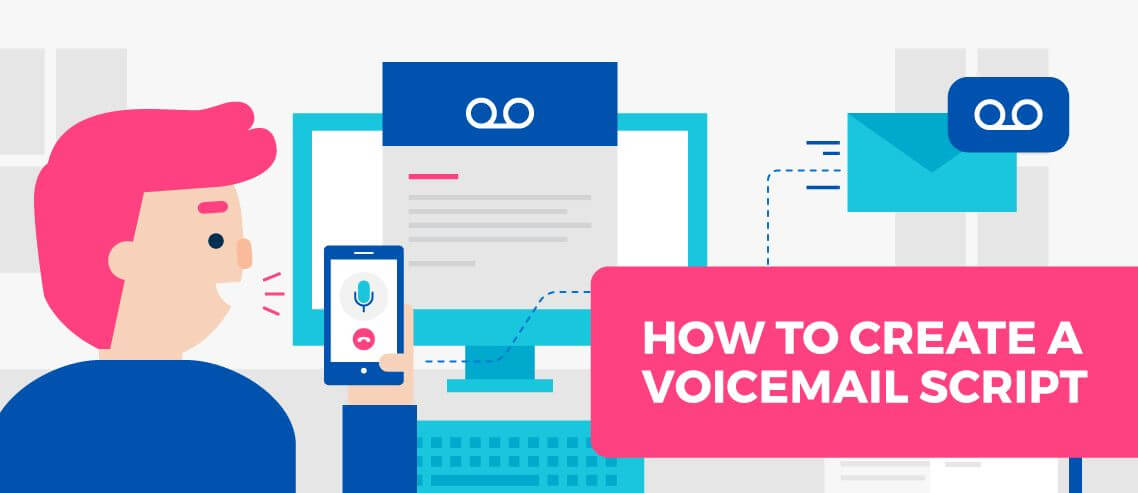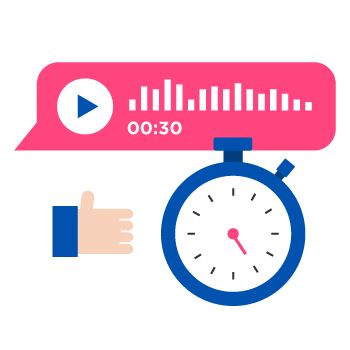How to Create a Voicemail Script

Contents
Leaving a sales voicemail almost doesn’t feel like a “real” sales activity. It’s what happens when you don’t achieve your first objective – speaking directly to your prospect.
Yet it takes up a big chunk of your working day. In fact, the average salesperson spends about 15% of their time on leaving voicemails.
As we all know, leaving a good voice message can be hard. There’s something about hearing the “beep” that causes us to clam up, stumble our words, and struggle to get our point across effectively.
If your salespeople are leaving the wrong types of voicemail, that’s a lot of wasted time and effort. Voicemail scripts could be a great solution.
Why Voicemail Scripts Are Worth Creating
You’ve probably already got a sales script. In fact, you likely have multiple variants.
But it’s not enough to rely on your “regular” sales script for voicemail – with no one at the other end of the line, it’s a totally different ball game.
That’s why you need a dedicated script for your sales voicemails.
You might think that scripting voicemails will hamper your salespeople’s natural creativity, but as Wendy Weiss of ColdCallingResults.com shared: “If you think before you speak, that is a script.”
After all, we each have an opening line, an elevator pitch, or closer that we roll out time and time again. Writing a voicemail script is just about bringing together all the elements you’re already using, elevating them, and formalizing them.
That way, when they hear the dreaded “beep,” your sales team is already armed with the perfect message rather than having to invent one on the fly.
Pre-Call Preparation
The process of leaving a quality sales voicemail that compels prospects to respond starts before you even pick up the phone. To begin, you’ll want to carry out this essential prep:
1. Define Your Goal

Without a clear objective in mind, it’s impossible to leave a voicemail that actually delivers results.
Most likely, the reason you’re calling that person is to persuade them to book an appointment. But what sort of appointment do you want them to book?
Is it a demo? A preliminary discussion with one of your product experts? A fact-finding mission to learn what they’re trying to achieve, and whether they’re a good fit for you?
Additionally, it’s important to remember what you’re not trying to achieve. You’re not going to convince them to leave their existing provider with a single voicemail, so don’t pitch them too aggressively.
Instead, you should simply be laying the groundwork for an ongoing conversation. More than likely, your prospect won’t return your call, so it’s essential that you always explain how you’ll be following up – whether it’s via another channel like email, or with another call in a few days (more on this later).
2. Know Your Audience
Ask yourself a bunch of questions about your product and how it specifically relates to the needs of your next prospect:
- What problem do you solve?
- Why do you believe the prospect has this problem?
- Why do you believe they want to solve this problem?
- What level of market knowledge do they have?
- Do they use a competitor’s product?
- Have they heard of you?
Understanding these points will help you craft a compelling voicemail pitch.
Unless all of your prospects have exactly the same pain points, you’ll likely need two or three variant scripts based on your answers to the above questions. Maybe you’ll have one script for a prospect that has heard of you and understands your market, and another for a prospect who’s experiencing a challenge that you can solve, but isn’t aware that products like yours exist.
Writing Your Voicemail Script
You understand the work that’s required upfront to deliver a compelling pitch via voicemail. Now it’s time to write your script. Here’s how to do it:
1. Understand the Optimal Voicemail Length

Voicemails aren’t the right medium for lengthy, nuanced messages. You want to make one point, clearly, in around 20 to 30 seconds.
Your prospects are busy – don’t expect them to fully listen to – and digest – a voicemail that clocks in at significantly longer than the half-minute mark. Most likely, they’ll delete it and forget all about it.
On the other hand, you need to give them some reason to reach out to you. They need to feel that you’ve identified a real problem they’re experiencing and have a solution. Chances are, you won’t be able to persuade them of that in less than 20 seconds.
So how many words do you have to play with? Well, the average person speaks at about 130 words per minute, so you’re looking at no more than 40-70 words in total.
That’s not a lot – so you need to make each word count.
2. Adopt the Right Tone
A voicemail is a one-way conversation. You can’t build rapport through back-and-forth discussion, and your prospect obviously can’t see you.
This means that you only have two means of winning your prospect over:
- The words you use
- Your tone of voice
While your words ultimately carry more weight, the way you speak still goes a long way to persuading prospects that you’re worth listening to.
So what does that mean for your voicemail?
Put simply, an engaging message delivered in a dull monotone likely won’t yield results. And if you clearly sound like a salesperson from the outset, you can bet that 99% of the time, your message will get deleted after a few seconds.
At the same time, you don’t want to come across as desperate, or nervous, or frantic, or panicked. None of those traits inspires confidence and trust in your expertise.
Instead, aim for a tone of voice that’s:
- Casual: Your posture is key here. Good posture helps you breathe better, which in turns helps you sound calmer.
- Confident: Speak with certainty by knowing exactly what you’re going to say, rather than letting your sentences trail off. And don’t raise the pitch of your voice unless you’re asking a question – it makes you sound uncertain.
- Friendly: Try smiling while you speak; it will help you come across as friendlier and more relaxed.
3. Identify Yourself & State Your Purpose
Straight off the bat, you need to clearly explain who you are and the reason you’re calling. And that reason must be compelling enough for your prospect to keep listening.
Calling “just to check in” isn’t a satisfactory reason, unless your prospect has specifically asked you to. It’s a lazy, unimaginative excuse for getting someone on the phone, and it hardly ever works.
Instead, you need to dig a little deeper.
For instance, let’s say this prospect has previously downloaded one of your ebooks. That gives you a legitimate reason for contacting them, and you should use it as a segue into the rest of your voicemail.
Thank them for downloading it, and tell them that you’re calling to learn more about what prompted them to download it and how you can offer them additional value through your product/service.
Example:
Hi, this is Sujan at Mailshake. I noticed that you downloaded our ebook, and I’m calling to explain how we can save you time on your prospecting outreach.
4. Refer to Common Pain Points & How You Solve Them
Unlike in a cold call, you don’t have the luxury of asking your prospect questions to understand their business challenges and goals.
But you (presumably) have some knowledge of their market. You know what they do. And you know about the pain points that keep people in similar roles at similar organizations awake at night.
Now’s your chance to discuss those pain points and reference how your product solves them.
Example:
Personalizing emails at scale is difficult, but we make it super simple with automation, so you can close more deals faster.
5. Ask for Action
It should be completely obvious what you want your prospect to do next.
Do you want them to return your call? Send an email? Respond to an invite or Calendly link you’ve sent them? Spell it out for them – and make it easy for them to take action.
This includes sharing your contact details, since there’s no chance that a prospect will reach out to you themselves if you don’t tell them how to contact you.
Example:
I’d love to explain how we can help [prospect’s company name], so call me back at [insert number]. I’ll follow up with an email tomorrow. Have a great day!
6. Consider Splitting Your Voicemails in Two
This can be an effective tactic.
Rather than leaving a single 30-second voicemail, you leave a 20-second message, then immediately call back and leave a 10-second message.
The first message will incorporate your regular voicemail script, but without your name and contact details.
The second voicemail could go something like this: “Hey [prospect name], just realized I didn’t leave my name and number – this is Sujan at Mailshake, you can get me at 512-123-4567.”
This works for a couple of reasons: it makes you stand out more, and it helps your messages come across as more spontaneous – less like you’re using a script.
Best Practices for Creating Your Voicemail Script
You’ve got the basics down. Ideally, you’ve written a couple variations on your script to bring a little personalization to your voicemail. Now, here are some pointers to maximize your results:
1. Make Space for Relationship-Building

Clearly, time is tight. But always try to leave yourself time to build bridges with your prospect.
Did you go to the same school as them? Do you have a common connection? Do you come from the same town, or follow the same sports team?
Giving yourself a few seconds at the top of your voicemail to reference your shared experiences can make your message a lot more impactful.
2. Always Keep Improving
Don’t just write two or three scripts and assume your work is done – always strive to keep elevating and optimizing.
In the previous section, we broke the ideal sales voicemail down into three steps:
- Introduction: Giving your name and stating your purpose
- Pitch: Referencing your prospect’s pain points and how you solve them
- Sign-off: Asking them to take action
Test different variations of each step and measure the results to see what works best. Which combinations generate the best response rates? Which lead to the best-quality responses? What’s the optimal call length?
Use the results to hone your script and share the latest, most effective variant across your sales team.
3. Don’t Forget to Follow Up
Sometimes, one voicemail may be all it takes to strike up a conversation. They might call back right away, eager to find out more about your fantastic product.
But it won’t always work. In fact, that’ll probably only happen in a minority of cases. That’s why it’s so important to spell out your follow-up plan when you’re leaving a sales voicemail.
Tell them that if you don’t hear from them, you’ll follow up with another call, email, or LinkedIn message in three to five days.
Again, test which approach delivers the best results – do you get better engagement when you follow up via LinkedIn? Do you get more responses when you wait for four days rather than three?
If you’re leaving a high volume of voicemails, you’ll have a mountain of data at your disposal, so make the most of it to improve your approach.





